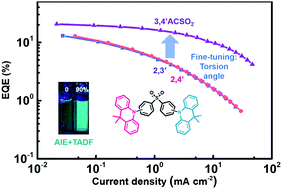Fine-tuning the photophysical properties of thermally activated delayed fluorescent emitters using torsion angles: high performance sky-blue OLEDs†
Abstract
Isomeric strategy is of great significance in molecular design owing to its profound influence on physical properties. Herein, three isomeric molecules, 2,3′ACSO2, 2,4′ACSO2, and 3,4′ACSO2, were designed by connecting two electron-donor (D) acridine units to an electron-acceptor (A) diphenylsulfone unit through an asymmetric connection method. All three compounds possess distinct thermally activated delayed fluorescence (TADF) and aggregation-induced emission (AIE) characteristics on account of the highly twisted D–A structure. Their photophysical and electroluminescent properties can be well regulated through this isomeric strategy. Owing to its proper torsion angles and high photoluminescence quantum yields (PLQYs), the 3,4′ACSO2 based device achieves a maximum external quantum efficiency of 20.5% with sky blue emission. These results demonstrate that the isomeric strategy fine-tuning of the torsion angles is a practical method to optimize photophysical and electroluminescence properties.



 Please wait while we load your content...
Please wait while we load your content...